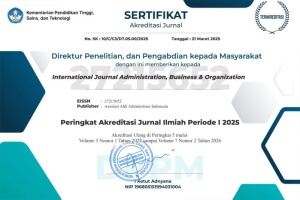The Impact of Intelligence Gathering, Risk Analysis, and Scenario Planning on Defense Policy Formulation
Abstract
In the evolving landscape of global security, the integration of intelligence gathering, risk analysis, and scenario planning is paramount for effective defense policy formulation. This study aims to underscore the critical role of these elements in contemporary defense strategies. Employing qualitative research methods, particularly secondary data analysis, this research investigates the transformative impact of artificial intelligence (AI) and machine learning (ML) on threat assessments, the benefits and challenges of big data analytics in risk analysis, and the value of interdisciplinary perspectives in scenario planning. The findings reveal that AI and ML significantly enhance the accuracy and reliability of threat assessments by enabling real-time data processing and predictive analytics. However, challenges such as data privacy and algorithmic biases persist. Big data analytics offers substantial benefits in identifying and mitigating emerging threats but requires robust data management frameworks to address issues of data quality and integration. Additionally, scenario planning is highlighted as a strategic tool that enhances defense strategies by anticipating various future scenarios and enabling proactive measures. Furthermore, the integration of interdisciplinary perspectives in scenario planning fosters more robust and adaptable defense policies, ensuring a comprehensive approach to security challenges. In conclusion, the integration of advanced technologies and interdisciplinary methods in intelligence gathering, risk analysis, and scenario planning is crucial for developing resilient and adaptive defense policies.
References
Abewardhana, A., Karunarathne, N. C., Dayarathne, H., Gamage, R., Lakmali, N., & Genovese, P. V. (2020). A Holistic Approach to National Security of Sri Lanka.
Adewusi, A. O., Okoli, U. I., Olorunsogo, T., Adaga, E., Daraojimba, D. O., & Obi, O. C. (2024). Artificial intelligence in cybersecurity: Protecting national infrastructure: A USA. World Journal of Advanced Research and Reviews, 21(1), 2263–2275.
Akhmaddhian, S., Supartono, T., Yuhandra, E., Budiman, H., & Rahmat, D. (2021, July). The government policy on the covid-19 handling viewed from environmental and biodiversity perspectives. In IOP Conference Series: Earth and Environmental Science (Vol. 819, No. 1, p. 012044). IOP Publishing.
Akhmaddhian, S. (2020). Discourse on Creating a Special Environmental Court in Indonesia to Resolve Environmental Disputes. Bestuur, 8(2), 129-138.
Akhgar, B., Saathoff, G. B., Arabnia, H. R., Hill, R., Staniforth, A., & Bayerl, P. S. (2015). Application of big data for national security: a practitioner’s guide to emerging technologies. Butterworth-Heinemann.
Alizadeh, R., Lund, P. D., Beynaghi, A., Abolghasemi, M., & Maknoon, R. (2016). An integrated scenario-based robust planning approach for foresight and strategic management with application to energy industry. Technological Forecasting and Social Change, 104, 162–171.
Al-Zahrani, A., & Al-Hebbi, M. (2022). Big data major security issues: challenges and defense strategies. Tehnički Glasnik, 16(2), 197–204.
Baiocchi, D., Blum, I., & Richardson, A. (2018). Defining and Assessing Adversary Threats to Space: Toward a Research Agenda. RAND Corporation.
Balarezo, J., & Nielsen, B. B. (2017). Scenario planning as organizational intervention: an integrative framework and future research directions. Review of International Business and Strategy, 27(1), 2–52.
Bates, D. W., Saria, S., Ohno-Machado, L., Shah, A., & Escobar, G. (2014). Big data in health care: using analytics to identify and manage high-risk and high-cost patients. Health Affairs, 33(7), 1123–1131.
Becker, D., King, T. D., & McMullen, B. (2015). Big data, big data quality problem. 2015 IEEE International Conference on Big Data (Big Data), 2644–2653.
Berlin, G., & Neskovic, D. (2018). Bayesian Predictive Threat Modeling in Border Security. Phalanx, 51(4), 24–27.
Bertalanffy, L. von. (1968). General system theory: Foundations, development, applications. G. Braziller.
Board, D. I. (2019). AI principles: recommendations on the ethical use of artificial intelligence by the department of defense: supporting document. United States Department of Defense.
Borum, R., Felker, J., Kern, S., Dennesen, K., & Feyes, T. (2015). Strategic cyber intelligence. Information & Computer Security, 23(3), 317–332.
Bouchama, F., & Kamal, M. (2021). Enhancing cyber threat detection through machine learning-based behavioral modeling of network traffic patterns. International Journal of Business Intelligence and Big Data Analytics, 4(9), 1–9.
Bracken, P. (2012). The second nuclear age: Strategy, danger, and the new power politics. Macmillan.
Braun III, W. G., & Allen, C. D. (2014). Shaping a 21st Century Defense Strategy. Joint Forces Quarterly, 73(2), 54.
Braun, V., & Clarke, V. (2021). Adapting Defense Doctrines to Hybrid Threats: Lessons from Recent Conflicts. Defense Studies, 22(4), 512–528.
Brown, S., Gommers, J., & Serrano, O. (2015). From cyber security information sharing to threat management. Proceedings of the 2nd ACM Workshop on Information Sharing and Collaborative Security, 43–49.
Budiman, H., Barokah, T., Harjadi, D., Fathanudien, A., & Anugrah, D. (2022, August). The Application of Legal System Theory in Handling Consumer Dispute by the Consumer Dispute Settlement Agency (BPSK) Of Kuningan Regency. In UNISET 2021: Proceedings of the 2nd Universitas Kuningan International Conference on System, Engineering, and Technology, UNISET 2021, 2 December 2021, Kuningan, West Java, Indonesia (p. 52). European Alliance for Innovation.
Budiman, H., Suwari Akhmaddhian, S., & Erga Yuhandra, E. (2024). Conservation-Based Spatial Planning Policy Formulation to Strengthen Tourism Districts. Pena Justisia.
Budiman, H., & Akhmaddhian, S. (2023). The Implications of Law No. 11 2020 Concerning Job Creation on Regional Spatial Planning and Watershed Management. Pena Justisia: Media Komunikasi dan Kajian Hukum.
Cetorelli, V. (2017). Scenario planning for military strategy: A methodological exploration. Military Psychology, 29(5), 359–371.
Chaniago, H., Muharam, H., & Efawati, Y. (2023). Metode Riset Bisnis dan Permodelan. Bandung: Edukasi Riset Digital, PT.
Chen, C. L. P., & Zhang, C.-Y. (2014). Data-intensive applications, challenges, techniques and technologies: A survey on Big Data. Information Sciences, 275, 314–347.
Chen, H., Chiang, R. H. L., & Storey, V. C. (2020). Business Intelligence and Analytics: From Big Data to Big Impact. MIS Quarterly, 36(4), 1165–1188.
Chen, M., Mao, S., & Liu, Y. (2014). Big data: A survey. Mobile Networks and Applications, 19, 171–209.
Chen, T. M., & Jøsang, A. (2020). The ethics of artificial intelligence and machine learning: A review and critique. Journal of Big Data and Society, 3(2), 1–19.
Choucri, N., Madnick, S., & Ferwerda, J. (2014). Institutions for cyber security: International responses and global imperatives. Information Technology for Development, 20(2), 96–121.
Clarke, R. A., & Knake, R. K. (2020). The Fifth Domain: Defending our country, our companies, and ourselves in the age of cyber threats. Penguin.
Creswell, J. W., & Creswell, J. D. (2017). Research design: Qualitative, quantitative, and mixed methods approaches. Sage publications.
Dalkıran, E., Önel, T., Topcu, O., & Demir, K. A. (2021). Automated integration of real-time and non-real-time defense systems. Defence Technology, 17(2), 657–670.
Davis, F. D. (1989). Perceived usefulness, perceived ease of use, and user acceptance of information technology. MIS Quarterly, 319–340.
Darmawan, E., Yusuf, F., Suseno, E., Budianto, H., & Maesyaroh, S. (2021, June). Decision support system for the selection of exemplary teachers using profile matching method. In Journal of Physics: Conference Series (Vol. 1933, No. 1, p. 012013). IOP Publishing.
De Spiegeleire, S., Maas, M., & Sweijs, T. (2017). Artificial intelligence and the future of defense: strategic implications for small-and medium-sized force providers. The Hague Centre for Strategic Studies.
Derbyshire, J. (2019). Use of scenario planning as a theory‐driven evaluation tool. Futures & Foresight Science, 1(1), e1.
Djalante, R., Holley, C., Thomalla, F., & Carnegie, M. (2013). Pathways for adaptive and integrated disaster resilience. Natural Hazards, 69, 2105–2135.
Djouzi, K., & Beghdad-Bey, K. (2019). A review of clustering algorithms for big data. 2019 International Conference on Networking and Advanced Systems (ICNAS), 1–6.
Djuniardi, D., Harjadi, D., & Fitriani, L. K. (2022, August). Problems, Motivation and Success of Women Entrepreneurs: a Study on the MSME Sector in Kuningan Regency, West Java During the Pandemic. In UNISET 2021: Proceedings of the 2nd Universitas Kuningan International Conference on System, Engineering, and Technology, UNISET 2021, 2 December 2021, Kuningan, West Java, Indonesia (Vol. 336). European Alliance for Innovation.
Eastman, R., Versace, M., & Webber, A. (2015). Big data and predictive analytics: on the cybersecurity front line. IDC Whitepaper, February.
El Khatib, M., Al Shehhi, H., & Al Nuaimi, M. (2023). How Big Data and Big Data Analytics Mediate Organizational Risk Management. Journal of Financial Risk Management, 12(1), 1–14.
Fjäder, C. O. (2018). Interdependence as dependence: Economic security in the age of global interconnectedness. In Geo-economics and power politics in the 21st Century (pp. 28–42). Routledge.
Flynn, S. (2004). America the vulnerable: How our government is failing to protect us from terrorism. HarperCollins New York.
Fraga-Lamas, P., Fernández-Caramés, T. M., Suárez-Albela, M., Castedo, L., & González-López, M. (2016). A review on internet of things for defense and public safety. Sensors, 16(10), 1644.
Freeman, L. (2020). Test and evaluation for artificial intelligence. Insight, 23(1), 27–30.
Frieden, J. A., Lake, D. A., & Schultz, K. A. (2019). World politics: interests, interactions, institutions. (No Title).
Gahi, Y., Guennoun, M., & Mouftah, H. T. (2016). Big data analytics: Security and privacy challenges. 2016 IEEE Symposium on Computers and Communication (ISCC), 952–957.
Ghavami, P. (2020). Big data management: Data governance principles for big data analytics. Walter de Gruyter GmbH & Co KG.
Gheorghe, A. V, Tatar, U., & Gokce, Y. (2017). Strategic Cyber Defense: A Multidisciplinary Perspective (Vol. 48). IOS Press.
Glenn, J. C., Gordon, T. J., & Florescu, E. (2014). 2013-14 State of the Future (Vol. 1). The Millennium Project.
Goldratt, E. M. (1990). Theory of constraints. North River Croton-on-Hudson.
Hao, K. (2020). How artificial intelligence has transformed the intelligence community. MIT Technology Review. Retrieved . MIT Technology Review. https://www.technologyreview.com/2020/07/08/1004721/how-artificial-intelligence-transformed-intelligence/](https://www.technologyreview.com/2020/07/08/1004721/how-artificial-intelligence-transformed-intelligence/
Herring, M. J., & Willett, K. D. (2014). Active cyber defense: a vision for real-time cyber defense. Journal of Information Warfare, 13(2), 46–55.
Hoadley, D. S., & Lucas, N. J. (2018). Artificial intelligence and national security. Congressional Research Service Washington, DC.
Holland, J. H. (1992). Complex adaptive systems. Daedalus, 121(1), 17–30.
Jain, R., Chandrasekaran, A., & Sharma, R. (2021). Big Data and Artificial Intelligence in Cyber Defense. Journal of Cyber Security Technology, 5(2), 67–83.
Jensen, B. M., Whyte, C., & Cuomo, S. (2020). Algorithms at war: the promise, peril, and limits of artificial intelligence. International Studies Review, 22(3), 526–550.
Johnson, J. (2019). Artificial intelligence & future warfare: implications for international security. Defense & Security Analysis, 35(2), 147–169.
Johnston, M. P. (2014). Secondary data analysis: A method of which the time has come. Qualitative and Quantitative Methods in Libraries, 3(3), 619–626.
Kaloudi, N., & Li, J. (2020). The ai-based cyber threat landscape: A survey. ACM Computing Surveys (CSUR), 53(1), 1–34.
Kasowaki, L., & Alp, K. (2024). Threat Intelligence: Understanding and Mitigating Cyber Risks. EasyChair.
Katuk, N., Vergallo, R., Sugiharto, T., & Krisdiawan, R. A. (2022). A client-based user authentication scheme for the cloud of things environment. Journal of Computer Science & Technology, 22.
Khan, A., Akhtar, N., Khan, S. U., & Jeon, G. (2021). A survey of the recent architectures of deep learning for anomaly detection. Neural Computing and Applications, 33, 1–22.
Koch, W. (2021). On digital ethics for artificial intelligence and information fusion in the defense domain. IEEE Aerospace and Electronic Systems Magazine, 36(7), 94–111.
Krippendorff, K. (2018). Content analysis: An introduction to its methodology. Sage publications.
Kröger, M., & Schäfer, M. (2016). Scenario development as a tool for interdisciplinary integration processes in sustainable land use research. Futures, 84, 64–81.
Labu, M. R., & Ahammed, M. F. (2024). Next-Generation cyber threat detection and mitigation strategies: a focus on artificial intelligence and machine learning. Journal of Computer Science and Technology Studies, 6(1), 179–188.
Maddireddy, B. R., & Maddireddy, B. R. (2020). Proactive Cyber Defense: Utilizing AI for Early Threat Detection and Risk Assessment. International Journal of Advanced Engineering Technologies and Innovations, 1(2), 64–83.
Manalu, V. G., Rahimi, F., & Akbar, I. (2023). Entrepreneurial Orientation and Product Innovation Performance of MSMEs in West Java: Foresight Capabilities as a Mediating Variable. Khazanah Sosial, 5(3), 508-519.
Manalu, V. G., & Adzimatinur, F. (2024). How Digital Transformation Can Affect Product Innovation Performance MSMEs: Evidence from West Java. Jurnal Aplikasi Manajemen, 22(1), 253-266.
Marotta, A., & McShane, M. (2018). Integrating a proactive technique into a holistic cyber risk management approach. Risk Management and Insurance Review, 21(3), 435–452.
Masruroh, R., Budiman, A., Dodi, D., Komarudin, M. N., & Irawan, N. (2024). Self Control and Organizational Commitment Views of Cyberloafing Behavior. JURISMA: Jurnal Riset Bisnis & Manajemen, 14(1), 167-174.
McCue, C. (2014). Data mining and predictive analysis: Intelligence gathering and crime analysis. Butterworth-Heinemann.
Michael, O., Crowley, S., Eigenbrode, S. D., & Wulfhorst, J. D. (2013). Enhancing communication & collaboration in interdisciplinary research. sage publications.
More, R., Unakal, A., Kulkarni, V., & Goudar, R. H. (2017). Real time threat detection system in cloud using big data analytics. 2017 2nd IEEE International Conference on Recent Trends in Electronics, Information & Communication Technology (RTEICT), 1262–1264.
Moudy, R. M., Ingerson-Mahar, M., Kanter, J., Grant, A. M., Fisher, D. R., & Jones, F. R. (2014). Bridging the health security divide: Department of Defense support for the Global Health security agenda. Biosecurity and Bioterrorism: Biodefense Strategy, Practice, and Science, 12(5), 247–253.
Nassar, A., & Kamal, M. (2021). Machine Learning and Big Data analytics for Cybersecurity Threat Detection: A Holistic review of techniques and case studies. Journal of Artificial Intelligence and Machine Learning in Management, 5(1), 51–63.
Nirmala, V. W., Harjadi, D., & Awaluddin, R. (2021). Sales forecasting by using exponential smoothing method and trend method to optimize product sales in pt. zamrud bumi indonesia during the covid-19 pandemic. International Journal of Engineering, Science and Information Technology, 1(4), 59-64.
Nurhandika, A., & Manalu, V. G. (2023). How poilitical connection moderate audit committee characteristics and csr: evidence from Indonesian companies. Jurnal Mantik, 7(3), 1653-1660.
Otaiku, A. A. (2018). A framework for hybrid warfare: Threats, challenges and solutions. J Def Manag, 8(178), 374–2167.
Page, S. (2008). The difference: How the power of diversity creates better groups, firms, schools, and societies-new edition. Princeton University Press.
Passeri, A., & Marston, H. (2022). The Pendulum of Non-Alignment: Charting Myanmar’s Great Power Diplomacy (2011–2021). Journal of Current Southeast Asian Affairs, 41(2), 188–213.
Petrozzino, C. (2020). Big data analytics: ethical considerations make a difference. Scitech Lawyer, 16(3), 14–21.
Plastiras, G., Terzi, M., Kyrkou, C., & Theocharides, T. (2018). Edge intelligence: Challenges and opportunities of near-sensor machine learning applications. 2018 Ieee 29th International Conference on Application-Specific Systems, Architectures and Processors (Asap), 1–7.
Polk, M. (2014). Achieving the promise of transdisciplinarity: a critical exploration of the relationship between transdisciplinary research and societal problem solving. Sustainability Science, 9, 439–451.
Porkoláb, I., & Zweibelson, B. (2018). Designing a NATO that thinks differently for 21st century complex challenges. Honvédségi Szemle–Hungarian Defence Review, 146(1), 196–212.
Rachmawati, E., Juminawati, S., Akbar, I., Bahri, K. N., & Cakranegara, P. A. (2018). The importance of understanding the application of marketing strategy for household MSME products on social media networks. International Journal of Business, Economics and Management, 5(1), 76-85.
Rashid, A. Bin, Kausik, A. K., Al Hassan Sunny, A., & Bappy, M. H. (2023). Artificial intelligence in the military: An overview of the capabilities, applications, and challenges. International Journal of Intelligent Systems, 2023(1), 8676366.
Rassam, M. A., Maarof, M., & Zainal, A. (2017). Big Data Analytics Adoption for Cybersecurity: A Review of Current Solutions, Requirements, Challenges and Trends. Journal of Information Assurance & Security, 12(4).
Rehman, M. H., Chang, V., Batool, A., & Wah, T. Y. (2022). Big Data Analytics in Information Systems Research: Challenges and Opportunities. Journal of Information Technology, 37(2), 102–123.
Riessman, C. K. (2008). Narrative methods for the human sciences. Sage.
Rijal, S., Sihombing, T. M., Akbar, I. A., Desembrianita, E., & Lubis, R. F. (2023). Peran Keunggulan Kompetitif, Inovasi Produk, dan Jaringan Bisnis terhadap Kinerja Ekonomi Daerah. Sanskara Ekonomi dan Kewirausahaan, 1(03), 173-185.
Riley, M., & Venables, D. (2020). The New Age of Risk Analysis in Defense. Defense and Security Journal, 11(3), 34–45.
Roff, H. (2020). Uncomfortable ground truths: Predictive analytics and national security. Brookings National Security Report.
Russell, S. J., & Norvig, P. (2016). Artificial intelligence: a modern approach. Pearson.
Sabillon, R., Serra-Ruiz, J., Cavaller, V., & Cano, J. (2017). A comprehensive cybersecurity audit model to improve cybersecurity assurance: The cybersecurity audit model (CSAM). 2017 International Conference on Information Systems and Computer Science (INCISCOS), 253–259.
Syamfithriani, T. S., Mirantika, N., Yusuf, F., & Kurniadi, E. (2021, June). M-Commerce application acceptance analysis using Technology Readiness Index (TRI) model in Kuningan Regency. In Journal of Physics: Conference Series (Vol. 1933, No. 1, p. 012012). IOP Publishing.
Sarjito, I. A. (2023). Kebijakan dan Strategi Pertahanan. CV Jejak (Jejak Publisher).
Sarker, I. H. (2024). AI-driven cybersecurity and threat intelligence: cyber automation, intelligent decision-making and explainability. Springer Nature.
Sayler, K. M. (2020). Artificial intelligence and national security. Congressional Research Service, 45178.
Schoemaker, P. J. H. (1993). Multiple scenario development: Its conceptual and behavioral foundation. Strategic Management Journal, 14(3), 193–213.
Shah, V. (2021). Machine Learning Algorithms for Cybersecurity: Detecting and Preventing Threats. Revista Espanola de Documentacion Cientifica, 15(4), 42–66.
Sharma, P., & Barua, S. (2023). From data breach to data shield: the crucial role of big data analytics in modern cybersecurity strategies. International Journal of Information and Cybersecurity, 7(9), 31–59.
Singh, A., Gupta, S. S., & Jain, M. M. (2022). Adaptation of Modern Technologies and Challenges in the Defense Sectors. Res Militaris, 12(2), 1547–1566.
Steinbock, D. (2014). The challenges for America’s defense innovation. The Information Technology & Innovation Foundation, 36(6), 366–374.
Supriadi, A., Djuniardi, D., & Hamzah, A. (2022). Pengaruh Overconfidence Bias, Mental Accounting Dan Familiarity Bias Terhadap Pengambilan Keputusan Investasi: (Studi Kasus Terhadap Korban Investasi Ilegal Binary Option). Journal of Global Business and Management Review, 4(1), 50-65.
Sutrisno, S., Agustiani, I., & Rahmantya, Y. E. K. (2023). Systematic Literature Review: Strategi Komunikasi Dalam Pemasaran Politik Partai. Jurnal Ilmiah Edunomika, 8(1).
Symon, P. B., & Tarapore, A. (2015). Defense intelligence analysis in the age of big data. Joint Force Quarterly, 79(4), 4–11.
Toops, S., Peterson, M. A., Vanderbush, W., Sackeyfio, N., & Anderson, S. (2021). International studies: An interdisciplinary approach to global issues. Routledge.
Unver, A. (2018). Digital open source intelligence and international security: a primer. EDAM Research Reports, Cyber Governance and Digital Democracy, 8.
Verma, S., Bhattacharyya, S. S., & Kumar, S. (2018). An extension of the technology acceptance model in the big data analytics system implementation environment. Information Processing & Management, 54(5), 791–806.
Wachjuni, W., Oktaviani, W., & Mahsyar, J. H. (2024). Strategies To Improve The Performance Of Msme’s In Kuningan Regency. Journal of Social Research, 3(2), 609-619.
Webster, J. L., Reif, W. E., & Bracker, J. S. (1989). The manager’s guide to strategic planning tools and techniques. Planning Review, 17(6), 4–48.
Weigand, K., Flanagan, T., Dye, K., & Jones, P. (2014). Collaborative foresight: Complementing long-horizon strategic planning. Technological Forecasting and Social Change, 85, 134–152.
Wibowo, S. K., & Rahmantya, Y. E. K. (2023). Systematic Literature Review Peran Teknologi Informasi Dan Komunikasi Terhadap Kinerja. Jurnal Ekonomi, Akuntansi & Manajemen, 3(1), 567-577.
Wickens, C. D., Gordon, S. E., Liu, Y., & Lee, J. (2004). An introduction to human factors engineering (Vol. 2). Pearson Prentice Hall Upper Saddle River, NJ.
Wiharno, H., Rahmawati, T., Martika, L., Nurhandika, A., & Dewi, R. (2021, March). Investment Risk: Empirical Evidence from Indonesia Stock Exchange. In Proceedings of the 1st Universitas Kuningan International Conference on Social Science, Environment and Technology, UNiSET 2020, 12 December 2020, Kuningan, West Java, Indonesia.
Xu, C., Qin, J., & Fang, Z. (2020). Predicting regional conflicts using machine learning and big data analytics. Journal of Conflict Resolution, 64(9), 1789–1816.
Yang, H.-B., Wang, X.-X., Liu, T.-T., Zhang, C., & Sun, D.-B. (2014). Practice Collaborative Innovation and Promote Interdisciplinary Integration. 2014 International Conference on Management Science and Management Innovation (MSMI 2014), 172–175.
Yuniawan, A. (2020). Artikel: Testing the Relationships between Human Resource Competence, Financial Aspect and SMEs Performance.
Yusuf, F., Rahman, T. K. A., & Subiyakto, A. (2024). Information Technology Readiness and Acceptance Model for Social Media Adoption in Blended Learning: A Case Study in Higher Education Institutions in West Java, Indonesia. Journal of Applied Data Sciences, 5(2), 382-402.
Yusuf, F., Mirantika, N., Syamfithriani, T. S., Darmawan, E., & Irawan, D. (2021, June). Technology readiness and acceptance model as a factor for the use intention of LMS e-Learning in Kuningan University. In Journal of Physics: Conference Series (Vol. 1933, No. 1, p. 012005). IOP Publishing.
Copyright (c) 2024 Aris Sarjito

This work is licensed under a Creative Commons Attribution-ShareAlike 4.0 International License.
Authors who publish in this journal agree to the following terms:
- The authors confirm that they are the authors of the submitted article, which will be published (online) in the journal IJABO (International Journal Administration, Business & Organization) by the Asosiasi Ahli Administrasi Indonesia (A3i), Bandung, Indonesia. The author’s name will be evident in the article. The publisher makes all decisions regarding the layout and distribution of the work.
- Authors guarantee that the work is their own original creation and does not infringe any statutory or common-law copyright or any proprietary right of any third party. In case of claims by third parties, authors commit themself to defend the interests of the publisher and shall cover any potential costs.
- Authors retain copyright and grant the journal the right of first publication, with the work simultaneously licensed under a Creative Commons Attribution-ShareAlike 4.0 International License (CC BY-SA 4.0). This license allows the redistribution and reuse of papers provided the authorship is properly credited.
- Authors can enter into separate, additional contractual arrangements for the non-exclusive distribution of the journal's published version of the work (e.g., posting it to an institutional repository or publishing it in a book), with an acknowledgment of its initial publication in this journal.
- Authors are permitted and encouraged to post their work online (e.g., in institutional repositories or on their website) prior to and during the submission process, as this can lead to productive exchanges and earlier and greater citations of published work.

















